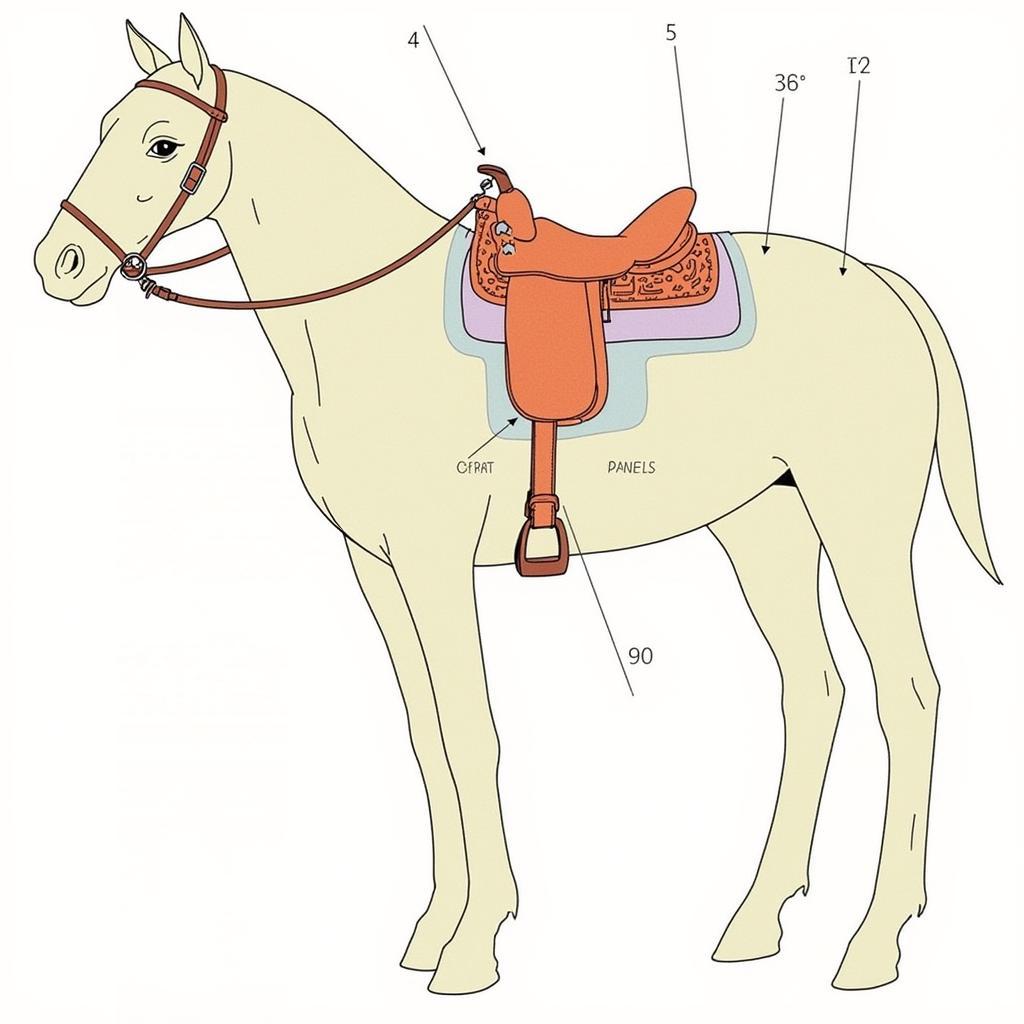Saddle Horse Parts encompass a complex and fascinating array of elements that work together to ensure the comfort, safety, and performance of both horse and rider. Whether you’re a seasoned equestrian or just beginning your journey, a thorough understanding of these components is essential. This comprehensive guide will delve into the intricacies of saddle horse parts, equipping you with the knowledge to make informed decisions for your equine partner.
Exploring the Anatomy of a Saddle
The saddle itself is the centerpiece of saddle horse parts and serves as the primary point of contact between horse and rider. It’s crucial to understand its key components:
Saddle Tree: The Backbone of Support
The saddle tree, typically crafted from wood or synthetic materials, forms the foundation of the saddle. It determines the saddle’s shape, fit, and weight-bearing capacity. A well-fitted tree distributes the rider’s weight evenly across the horse’s back, preventing pressure points and discomfort.
Seat: Where Rider Meets Horse
The seat is where the rider sits and its size and shape vary depending on the riding discipline. A deep seat offers more security for jumping, while a flatter seat allows for greater freedom of movement in dressage.
Panels: Cushioning the Ride
Positioned beneath the seat, panels provide cushioning and impact absorption for the horse’s back. These padded sections are typically filled with wool, foam, or air and play a crucial role in ensuring the horse’s comfort.
Stirrups: Finding Your Balance
Suspended from the saddle tree by stirrup leathers, stirrups provide support for the rider’s feet. They allow the rider to maintain balance and apply aids effectively. Stirrup length is adjustable to accommodate rider leg length and riding style.
 Saddle Parts Diagram
Saddle Parts Diagram
Bridles and Bits: Communication and Control
Beyond the saddle, bridles and bits are essential saddle horse parts, enabling communication and control between horse and rider.
Bridle: Headpiece for Guidance
The bridle, a series of leather straps fitted around the horse’s head, forms the foundation for attaching the bit and reins. It includes a headstall that goes over the horse’s ears, a throatlatch that prevents the bridle from slipping over the horse’s head, and a noseband that helps to keep the horse’s mouth closed.
Bit: The Metal Mouthpiece
The bit, a metal mouthpiece that rests on the horse’s bars (the sensitive area between their front and back teeth), allows the rider to communicate cues through pressure. Bits come in various shapes and sizes, each designed for specific purposes and levels of rider experience.
Saddle Pads and Accessories: Enhancing Comfort and Protection
While the saddle and bridle are fundamental, numerous accessories enhance comfort, protection, and performance.
Saddle Pads: Absorbing Shock and Moisture
Saddle pads, placed between the saddle and the horse’s back, provide an extra layer of cushioning and help to absorb sweat. They come in various materials like sheepskin, felt, or synthetic fabrics.
Girths and Cinchas: Securing the Saddle
Girths (for English saddles) and cinchas (for Western saddles) are wide straps that fasten around the horse’s girth area, securing the saddle in place. They come in different materials and designs to suit various riding styles and horse conformations.
Martingales: Controlling Head Carriage
Martingales are training aids that attach to the girth, reins, and noseband, helping to control the horse’s head carriage. They are particularly useful for young or excitable horses and are used in various disciplines.
Choosing the Right Saddle Horse Parts
Selecting the appropriate saddle horse parts is paramount for the well-being and performance of both horse and rider.
Consider these factors when choosing saddle horse parts:
- Horse’s Conformation: The saddle and bridle must fit the horse’s unique back shape, head size, and mouth conformation.
- Riding Discipline: Different disciplines require specialized equipment. For instance, a dressage saddle differs significantly from a Western saddle.
- Rider’s Experience and Skill Level: Choosing a bit appropriate for the rider’s skill level ensures clear communication and prevents discomfort for the horse.
Caring for Your Saddle Horse Parts
Proper care and maintenance of your saddle horse parts ensure their longevity and optimal performance:
- Regular Cleaning: Clean your saddle, bridle, and other accessories regularly using appropriate leather cleaners and conditioners to prevent dirt and sweat buildup.
- Proper Storage: Store your saddle and bridle in a cool, dry place when not in use. Avoid storing leather equipment in direct sunlight or extreme temperatures.
- Regular Inspections: Check for any signs of wear and tear, such as cracked leather, loose stitching, or damaged hardware. Address these issues promptly to prevent further damage and ensure safety.
Conclusion
Understanding saddle horse parts is a journey of continuous learning. By familiarizing yourself with the various components, their functions, and the factors influencing your choices, you can ensure a safe, comfortable, and enjoyable riding experience for both you and your equine partner. Remember, investing in high-quality, well-fitting equipment is an investment in the well-being and performance of your horse.
Need help finding the perfect saddle horse parts for your needs? Contact Justus Horses USA at 0772127271 or email us at [email protected]. We’re here to help you every step of the way. Visit our location at QGM2+WX2, Vị Trung, Vị Thuỷ, Hậu Giang, Việt Nam, and let our expert team guide you.